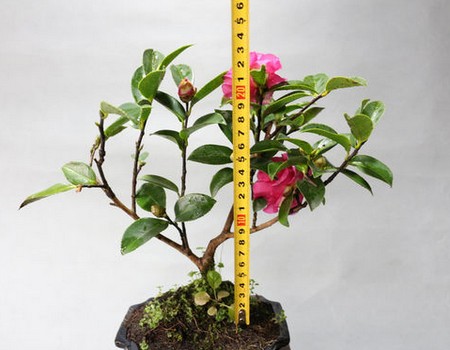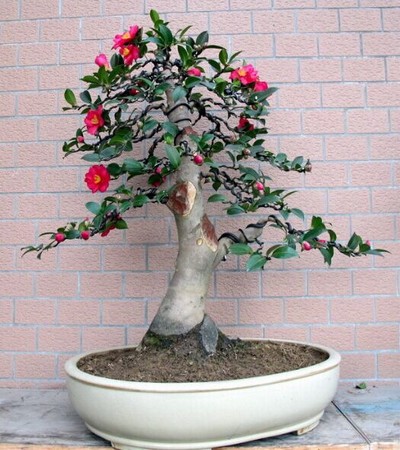The modeling method of tea plum bonsai
Tea plum has been favored by people since ancient times. it has exquisite posture, elegant leaf shape, beautiful flowers and long flowering period. it is a famous flower with excellent ornamental flowers and foliage. The purpose of making tea plum bonsai is to watch, the premise of viewing is to give tea plum a good shape, so how to shape is a very important point, the following editor will tell you some methods to give tea plum shape.

Pruning and plastic surgery of tea plum can be carried out all year round, but it is best to do so after flowering to before the new shoots germinate. The time of pruning and setting can be extended from December to February to March of the following year. Pruning and shaping should grasp the following principles: the cut should be smooth, leaving no residual piles, leaving 3 branches per plant, and reserving the leading branches on each branch.
[trunk treatment]
It is necessary to combine the natural characteristics of different varieties of tea plum, to shape the trunk by climbing or twisting, or to cut off the top tip to promote the bud in the axil to germinate quickly and increase the number of branches, which is conducive to the formation of crown and layer. it is also possible to cut off the trunk and retain the side branches and store them into a Qiu branch crown year by year, but we should pay attention to the symmetry between the trunk and branches.
1. The trunk of the straight trunk should be straight or slightly bent, and the base of the trunk should be slightly thick and gradually small upward.
2. The double-trunk shape should be close to the base of the trunk, and the height is different.
3. The oblique trunk should be tilted, but can not lie down, generally keep about 45 °, the inclined part of the trunk is more than 1/2 of the total length, and the crown should be put straight at last.
4. The curved trunk should be bent naturally and moderately in proportion, instead of bending back and forth at the same level, and should be scattered back and forth.
[branch treatment]
The length and density of branches should be coordinated with the height and thickness of the trunk. Branches that are too dense can be trimmed moderately, do not let them blossom for the first two to three years, and do not be too hasty in the process of posture.
As the branches are relatively brittle and hard, especially where the branches are easy to break, special care should be taken. For individual slender branches, in addition to the long branches that can be cut off or cut short, lead wire twist is generally used to shorten the shape, and the shape should be thick rather than thin. The best shape is processed year by year.
[leaf treatment]
Through the treatment of branches and leaves and twigs, ingenious combination, to achieve a reasonable layout, proportion coordination.
The relationship between leaves and leaves should be dealt with more but not complicated, less but not sparse, and some can be cut off properly for the coordination of branches and leaves and plants.
In the process of cultivation, fertilizer and water should be properly restricted to make the leaves smaller as much as possible.
[root treatment]
The root treatment should be combined with the posture of the trunk, such as the straight-dried root should be slightly exposed, the curved-dry root should be more exposed, the root should be tangled, and the cliff root should be exposed on the other side of the upside down.
Time: 2019-06-11 Click:
- Prev

The Propagation method of Broad Leaf Top Ten efforts
The broad leaves are evergreen all the year round, the tree shape is elegant, the branches and leaves are strange, and the flowers and colors are beautiful, so it is very suitable for ornamental tree species with greening. Can be used to decorate courtyards, water pavilions, etc., often with rocks. According to the research and determination, the tree is resistant to polluted gas and can be used for greening in industrial parks. It can also be planted around rural orchards and vegetable gardens.
- Next

Pruning method of tea plum bonsai
Tea plum bonsai can be trimmed and reshaped all the year round. Seasonally, it can be divided into spring, summer, autumn and winter. Pruning and shaping in winter and spring, the pruned branches have a strong ability to sprout, and more buds will sprout after pruning. therefore
Related
- Fuxing push coffee new agricultural production and marketing class: lack of small-scale processing plants
- Jujube rice field leisure farm deep ploughing Yilan for five years to create a space for organic food and play
- Nongyu Farm-A trial of organic papaya for brave women with advanced technology
- Four points for attention in the prevention and control of diseases and insect pests of edible fungi
- How to add nutrient solution to Edible Fungi
- Is there any good way to control edible fungus mites?
- Open Inoculation Technology of Edible Fungi
- Is there any clever way to use fertilizer for edible fungus in winter?
- What agents are used to kill the pathogens of edible fungi in the mushroom shed?
- Rapid drying of Edible Fungi

